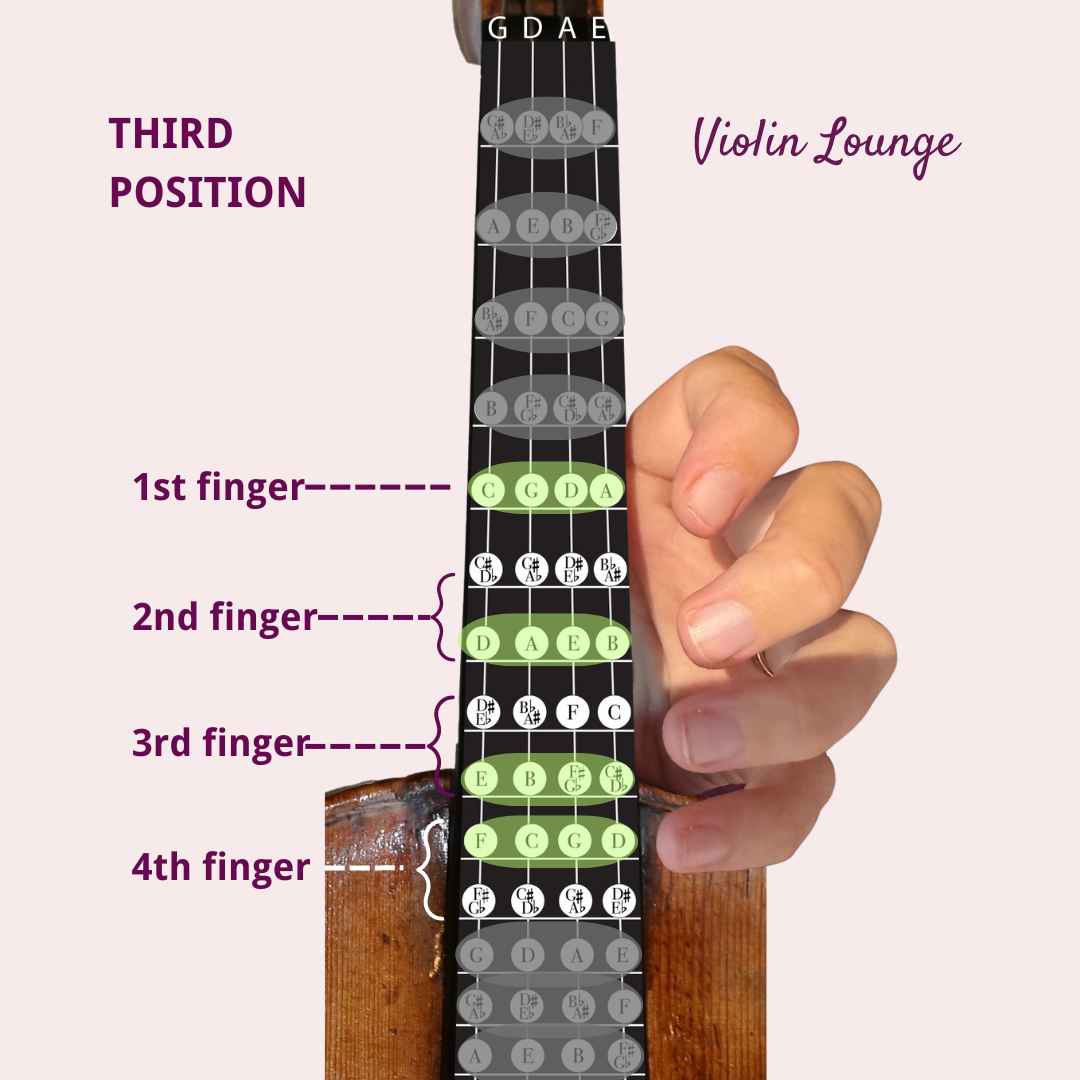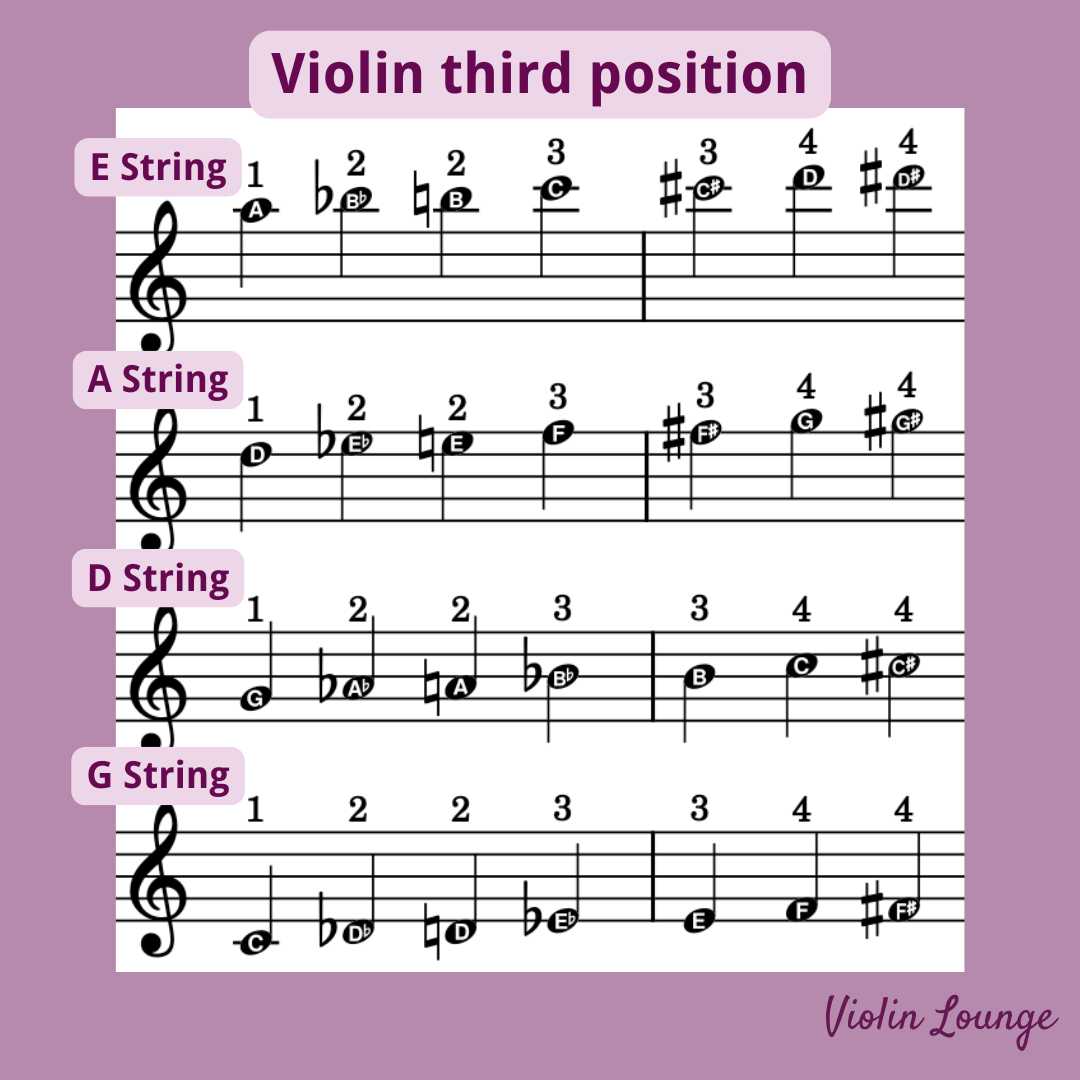Violin Third Position – all notes, finger chart and exercises
Learning the third position on the violin really opens some possibilities
If you’ve just recently started doing position work and shifting, you’re most likely working on third position. It is absolutely one of the most commonly used violin positions. The finger spacing is comfortable, and the basic third position hand frame uses the same scales as first position. Many teachers also consider it the best way to initially learn vibrato, which we will touch on later.
Finding third position
Third position starts about half way between the fingerboard nut and the edge of the violin (also called the “purfling”). Your palm, wrist, and arm are able to hang down freely, elbow pointing at the ground. To find it, slide your first finger on A string from B up to D. This is the start of third position, where third finger would normally be.
Finger chart of third position
This chart will help you visualize and understand the third position and it’s left hand posture:

Notes in Third Position
The full chromatic range of notes you can play in third position are as follows:
G string: C, C#/D♭, D, D#/E♭, E, F, F#/G♭
D string: G, G#/A♭, A, A#/B♭, B, C, C#/D♭
A string: D, D#/E♭, E, F, F#/G♭, G, G#/A♭
E string: A, A#/B♭, B, C, C#/D♭, D, D#/E♭
Sheet music of the third position
This is what the third position notes look like in violin sheet music. I’ve chosen between notes that are enharmonically the same. Of course if a F# is possible, a Gb is possible too (also see the finger chart above).

Example of Third Position
Once you get past beginning stages, third position is INCREDIBLY common in all levels of violin repertoire. It is crucial to understand sheet music markings to know when third position is required or encouraged. It is often used for more lyrical passages, to avoid awkward string crossings, or to create a different color. In some cases, playing third position is often a performer’s personal choice.
As an example, if you see a 1 written where you would put third finger in first position, shift to third. If you use the finger chart above to learn the notes in third position, you will be able to tell when to shift and what finger goes with each note.
Here is a clip from the famous piece Czardas by Vittorio Monti. Most of this piece’s fast section is in third position. Notice how this makes string crossing easier and allows for higher notes. Make sure to start the video at 2:40.
Exercises and pieces in the third position
As noted above, third position is everywhere! It is so easy to find long examples of it in many pieces. Here are some great exercise books and pieces that will help you strengthen this skill:
- Third and Fifth Position String Builder by Samuel Applebaum
- Introducing the Positions Vol. 1 by Harvey S. Whistler
- Czardas by Monti
- Meditation de Thais by Massenet
- Concerto in A Minor Mov. 1 by Vivaldi
There are many intermediate student concertinos you can play when you get proficient in first and third position. Here’s a list of 34 student concertinos in first and third position plus free sheet music.
How to Learn Third Position
It is so important to nail the first to third position shift. If you have not shifted before, here’s a few tips to keep in mind:
- Allow your left thumb to be loose and flexible. Gripping the neck prevents shifting and causes injury.
- When you shift, don’t just slide the finger. Allow your entire lower arm, wrist, and hand to move as one.
- Keep the finger you are shifting just slightly (but not tightly) touching the string for a smooth motion.
- When practicing slow shifts, do not overshoot the shift. It’s okay to slide up slowly at first, but overshooting will teach you to play out of tune.
- Keep your other fingers close to the fingerboard for speed and to maintain hand frame.
A great way to start learning the notes of third position is to play one-octave scales. The basic scales of third position (C major, G major, and D major) match the ones you learned early in first position. They will sound familiar and have easy fingering patterns. To play the D Major scale in third position, start with first finger on A string and go all the way up to fourth finger on E string. As you learn the notes, you will start to notice some pretty cool relationships between first and third positions. What are some things you notice already?
Note on Harmonics
Third position is also when you begin using natural harmonics. The harmonic series is a musical and physical phenomenon. We won’t go into the science here, but basically, if you rest your finger on the surface of the string at its exact midpoint, it produces a pure, ringing tone. You do not even have to push your finger down! This happens because of the equivalent vibrations in the two sides of the string. There are several different sets of natural harmonics on violins, but dividing the string in half is the main one. The note produced is one octave higher than its corresponding open string. (G for G string, D for D string, etc.) Technically, the harmonics are in fourth position, but there are many intermediate pieces in third position that will stretch up for a harmonic, so they are usually taught simultaneously. Read my easy guide to violin harmonics here.
Note on Vibrato
Many more advanced violinists actually find playing third position even more enjoyable than first. Since it is further from the scroll, it is easier to have a loose, relaxed hand. For this reason, some pedagogues teach vibrato through third position. If you started learning vibrato exclusively in first position but have been struggling, try doing your exercises in third position instead! For more help with this, watch my video on learning vibrato on the violin.
Free third position violin course
I’d love to help you further to really learn the third postion and play some beautiful music. Join my FREE third position challenge and we’ll cover:
- learning to play in tune in the third position
- shifting back and forth between first and third position
- scales in the third position
- play Meditation from Thaïs by Massenet (an easy arrangement I made)
It includes video lessons and sheet music. Click here to join and I hope to see you there.


0 Comments